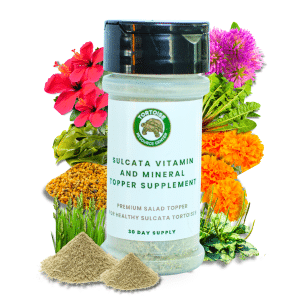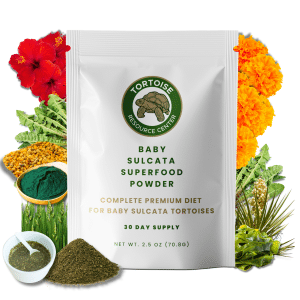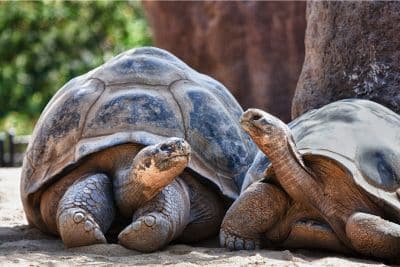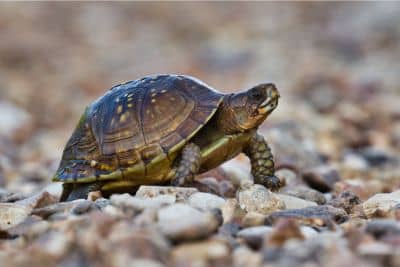While there are nearly 50 different tortoise species in the world, beginning tortoise enthusiasts often find themselves choosing from a relatively small subset of this total.
After all, some tortoises – such as Aldabra tortoises (Aldabrachelys gigantea) – simply grow too large for the average keeper. Meanwhile, the prices associated with radiated tortoises (Astrochelys radiata), pancake tortoises (Malacochersus tornieri), and other rare species are higher than most beginners are willing to pay.
Instead, beginners are generally looking for relatively small and affordable species. There aren’t a ton of options that meet these criteria, but Hermann’s tortoises (Testudo hermanni) and Russian tortoises (Testudo horsfieldii) check both of these boxes.
Both species can make excellent pets, and in this article, I’ll share some of the most important information you’ll want to consider so that you can select the best one for your situation.
Basic Information
It is important to familiarize yourself with the basic information about any tortoise species you intend to keep. This includes things like the tortoise’s geographic range and habitat preferences, as well as the tortoise’s size, diet, and typical behavior.
This is especially important for keepers who’re trying to decide between two somewhat similar species.
Appearance
Russian and Hermann’s tortoises are somewhat similar-looking, and both have a yellow to khaki ground color, with dark brown to black markings on their carapaces.

Both species are highly variable, and even siblings can look quite different from each other. However, Hermann’s tortoises generally have more and larger markings, which are often more complex than the typically squarish markings Russian tortoises bear. In some cases, the markings will appear as black scute borders, often with a smaller black mark at the centre of the scute.
Most hobbyists consider Hermann’s tortoises to be the more attractive of the two species, but beauty is obviously in the eye of the beholder.

Size and Space Requirements
Hermann’s tortoises and Russian tortoises are both relatively small when compared to Aldabra tortoises, sulcatas (Centrochelys sulcata), and other giants. Both species tend to reach about 4 to 8 inches in length, although eastern Hermann’s tortoises grow somewhat larger and may reach up to 11 inches in length on occasion.
In terms of enclosure space, these tortoises will need between about 8 and 16 square feet of space, though enclosures that provide 25 square feet or more would be preferable (especially in the case of large eastern Hermann’s tortoises).
Geographic Range
These tortoises live in slightly different geographic regions. Hermann’s tortoises are found across the southern portion of Europe, from isolated locations in Spain to Greece, Bulgaria, and Romania.
Most authorities currently recognize two subspecies of the Hermann’s tortoise, with the eastern subspecies (T. h. boettgeri) being native to the Balkan Peninsula and the western subspecies (T. h. hermanni) is found around the perimeter of Italy, the island of Cagliari, and in scattered portions of France and Spain.
Russian tortoises, on the other hand, inhabit a broad swath of land in central Asia (hence one of their other common names, the central Asian steppe tortoise). In total, their range includes parts of Russia, China, Azerbaijan, Kazakhstan, Kyrgyzstan, Tajikistan, Turkmenistan, Uzbekistan, and Pakistan.
Preferred Habitat
Both tortoises are commonly found in open areas, however, the Hermann’s tortoise also inhabits forests in several parts of its range (especially in the eastern portion of its range). Hermann’s tortoises are more likely to be associated with rocky regions that are covered in Mediterranean-style vegetation, while Russian tortoises primarily inhabit grassy areas with sandy soils.
Climate Preferences
Because they’re restricted to coastal regions, western Hermann’s tortoises typically enjoy a very mild Mediterranean climate characterized by hot summers and mild, wet winters. By contrast, members of the eastern subspecies must cope with cooler winter temperatures as they’re found further inland.
Nevertheless, Russian tortoises, being found even further inland, experience much more drastic seasonal changes. The summers are warm and pleasant, if short, but the winters throughout most of their range are long and frigid. This causes wild Russian tortoises to brumate for six months or more in some cases.
Are You Starving Your Tortoise?
Save 10% on premium tortoise food and supplements from Tortoise Resource Center on Amazon now using code BUYNOWGET10

Sulcata Vitamin & Mineral Topper Supplement
30-Day Supply | 2 oz (56 g)
$24.99

Baby Sulcata Tortoise Superfood Powder
30-Day Supply | 2.5 oz (70.8 g) Bag
$24.99
Diet
Hermann’s tortoises and Russian tortoises both consume relatively similar diets, which are primarily comprised of various grasses, sedges, weeds, and flowers. They do not consume as much fruit as species hailing from tropical forests, nor should they be provided with such in captivity (though the occasional bit of fruit certainly won’t cause serious health problems).

Both species will occasionally consume the odd insect or bit of carrion, though this is not recommended for captive individuals.
Personality and Demeanor
Both of these tortoise species make fairly docile and easy-going captives (which is a significant part of their appeal). However, Russians are often described as being slightly more outgoing, while Hermann’s tortoises tend to be more laid back and shy.
Both species will quickly learn to associate their keepers with food, which may lead them to “chase” their keepers when present.
Breeding
In most respects, Hermann’s tortoises and Russian tortoises exhibit similar reproductive approaches. They tend to engage in elaborate courtship rituals in the spring, immediately after emerging from brumation. Breeding usually follows in short order, with eggs being laid about four to six weeks later.
Both species may produce multiple clutches in the same breeding season. Egg count totals are generally similar, and range from two to six each year, however, large Hermann’s tortoises may deposit as many as 12 eggs in a season on occasion.
Availability
Perhaps the most significant difference between these two species (at least, from a keeper’s perspective) relates to their availability. Both tortoises are readily available on the open market, but Russian tortoises are far more common and more affordably priced.
This is primarily because Hermann’s tortoises are protected across their range; only captive-bred animals can be purchased legally. Captive-bred Hermann’s tortoises certainly aren’t “common” in the pet trade, but they’re common enough that their prices are still reasonable.
By contrast, Russian tortoises lack the protection Hermann’s tortoises enjoy. Wild-caught Russian tortoises are not only available, but they drastically outnumber captive-bred individuals.
Wild-caught Russian tortoises are very affordably priced, but – like most wild-caught animals – they often exhibit significant health problems and have trouble acclimating to captivity. Nevertheless, captive-bred Russian tortoises are available from time to time, though they command higher prices than wild-caught individuals.

Hermann’s Tortoise Vs Russian Tortoise: A Buyer’s Guide
Now that you understand some of the basic information about Hermann’s tortoises, I can begin helping you to choose the best one for your situation. Just remember that both of these species typically make very good pets, and most keepers are likely to enjoy caring for either one.
However, the following considerations will generally help most prospective keepers decide which one will work best:
- If you live in a relatively cool area and want to keep your tortoise outdoors, you should select a Russian tortoise. Because Russian tortoises hail from areas with colder, longer winters, they’re more likely to thrive in cooler climates. Nevertheless, you’ll still need to provide your pet with sufficiently high daytime basking temperatures (at least 90 degrees Fahrenheit) during the active season.
- If you’d prefer a more strikingly marked pet, the Hermann’s tortoise is likely the best option. While some Russian tortoises bear attractive markings, Hermann’s tortoises generally have more highly contrasting and intricate markings, which many keepers prefer.
- If you want to avoid wild-caught tortoises at all costs, select a Hermann’s tortoise. While you can find captive-bred Russian tortoises, they’re somewhat rare. By contrast, all Hermann’s tortoises that are legally offered for sale are captive bred.
- If you’re interested in breeding your tortoise, select a Hermann’s tortoise. Because most Hermann’s tortoises are captive-bred, they’re more likely to breed in captivity (wild-caught animals can be very tricky to breed). Additionally, because they’re bred more often, there is more information available about their breeding habits, and the best methods by which you can trigger successful reproduction.
- If you are interested in the most affordable option above all else, you should select a Russian tortoise. Russian tortoises can almost always be purchased for less than Hermann’s tortoises can. However, it is important to realize that this is because most Russian tortoises are wild-caught individuals, who’ll often require veterinary care to thrive. This may offset any money you save when purchasing the animal.
- If you have space limitations, a Russian tortoise will likely be the better choice. While eastern Hermann’s tortoises often remain smaller than some Russian tortoises, they’re less common in the pet trade. Western Hermann’s tortoises often reach much larger sizes than Russian tortoises, which means they’ll require larger enclosures.
Citations
- Tortoise Library – Russian Tortoises (Testudo horsfieldii)
- The Links Road Animal & Bird Clinic — May 2023’s Animal Of The Month – Hermann’s Tortoises
- Hermanni Haven – Hermann’s Tortoise Subspecies


